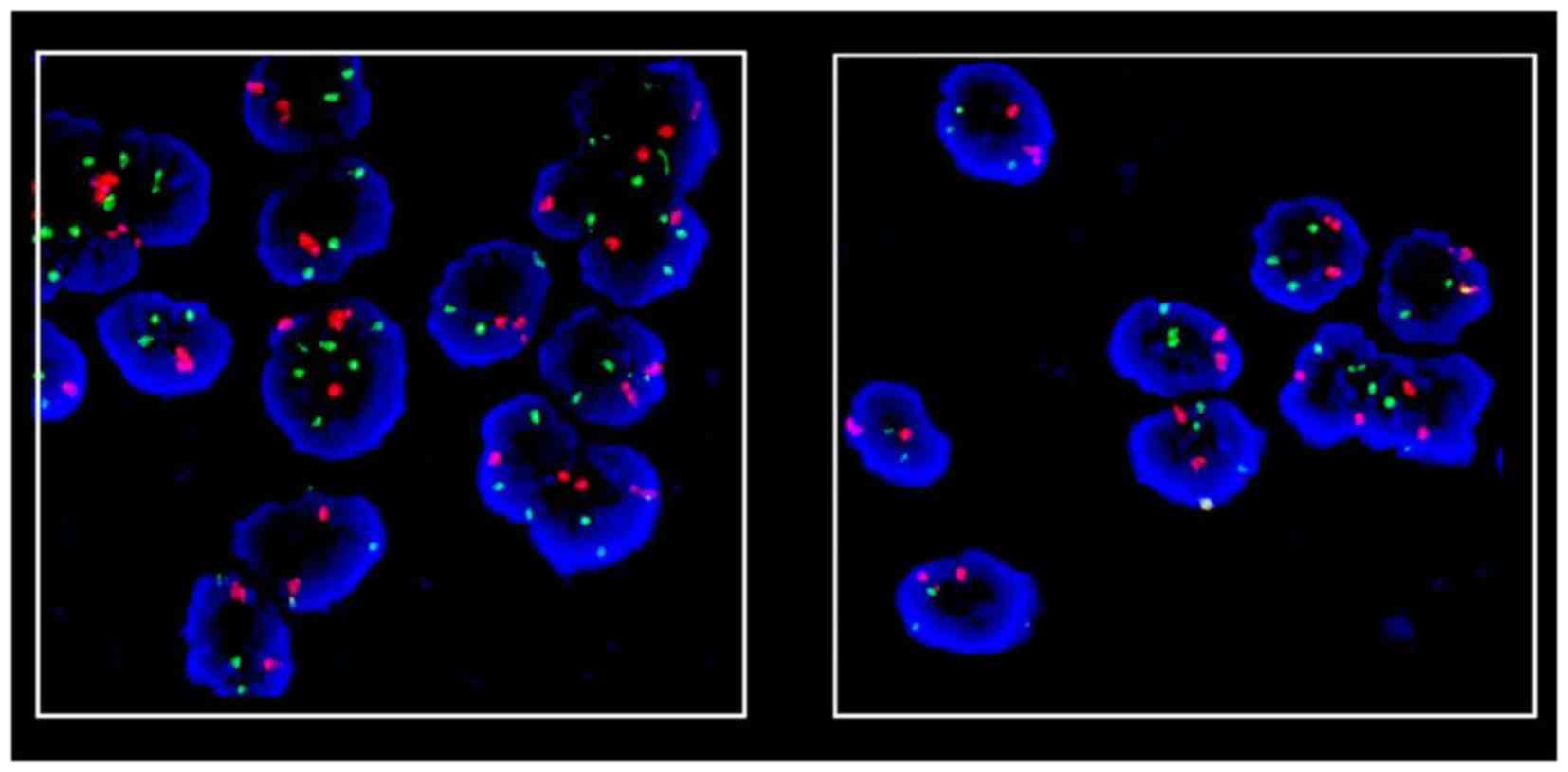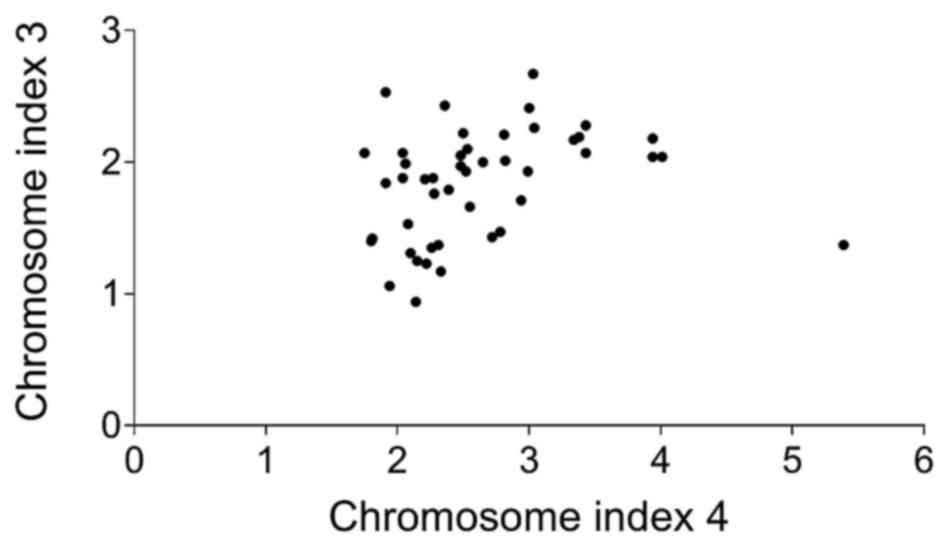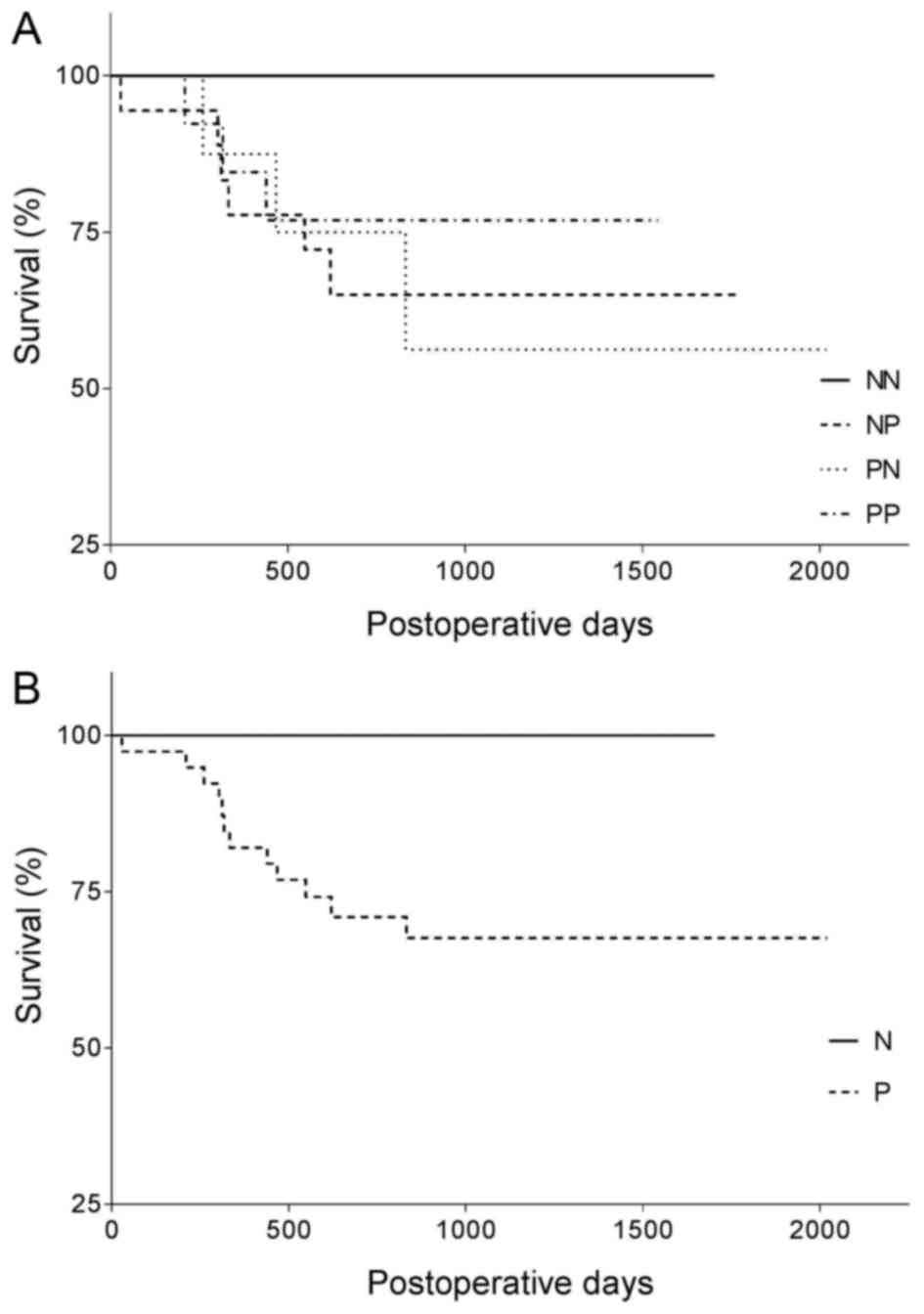|
1
|
Perry JD and Singh AD: Uveal melanoma:
Epidemiologic aspects. Clin Ophthalmic Oncol. 75–87. 2014.
|
|
2
|
Mooy CM and De Jong PT: Prognostic
parameters in uveal melanoma: A review. Surv Ophthalmol.
41:215–228. 1996. View Article : Google Scholar : PubMed/NCBI
|
|
3
|
Dopierala J, Damato BE, Lake SL, Taktak
AFG and Coupland SE: Genetic heterogeneity in uveal melanoma
assessed by multiplex ligation-dependent probe amplification.
Invest Ophthalmol Vis Sci. 51:4898–4905. 2010. View Article : Google Scholar : PubMed/NCBI
|
|
4
|
Mensink HW, Vaarwater J, Kiliç E, Naus NC,
Mooy N, Luyten G, Brüggenwirth HT, Paridaens D and de Klein A:
Chromosome 3 intratumor heterogeneity in uveal melanoma. Invest
Ophthalmol Vis Sci. 50:500–504. 2009. View Article : Google Scholar : PubMed/NCBI
|
|
5
|
Damato B: Does ocular treatment of uveal
melanoma influence survival? Br J Cancer. 103:285–290. 2010.
View Article : Google Scholar : PubMed/NCBI
|
|
6
|
Abildgaard SKO and Vorum H: Proteomics of
uveal melanoma: A minireview. J Oncol. 2013:8209532013. View Article : Google Scholar : PubMed/NCBI
|
|
7
|
Hughes S, Damato BE, Giddings I, Hiscott
PS, Humphreys J and Houlston RS: Microarray comparative genomic
hybridisation analysis of intraocular uveal melanomas identifies
distinctive imbalances associated with loss of chromosome 3. Br J
Cancer. 93:1191–1196. 2005. View Article : Google Scholar : PubMed/NCBI
|
|
8
|
Kilic E, van Gils W, Lodder E, Beverloo
HB, van Til ME, Mooy CM, Paridaens D, de Klein A and Luyten GP:
Clinical and cytogenetic analyses in uveal melanoma. Invest
Ophthalmol Vis Sci. 47:3703–3707. 2006. View Article : Google Scholar : PubMed/NCBI
|
|
9
|
Onken MD, Worley LA and Harbour JW: A
metastasis modifier locus on human chromosome 8p in uveal melanoma
identified by integrative genomic analysis. Clin Cancer Res.
14:3737–3745. 2008. View Article : Google Scholar : PubMed/NCBI
|
|
10
|
Häusler T, Stang A, Anastassiou G, Jöckel
KH, Mrzyk S, Horsthemke B, Lohmann DR and Zeschnigk M: Loss of
heterozygosity of 1p in uveal melanomas with monosomy 3. Int J
Cancer. 116:909–913. 2005. View Article : Google Scholar : PubMed/NCBI
|
|
11
|
van den Bosch T, Kilic E, Paridaens D and
de Klein A: Genetics of uveal melanoma and cutaneous melanoma: Two
of a kind? Dermatol Res Pract. 2010:3601362010.PubMed/NCBI
|
|
12
|
Onken MD, Worley LA, Ehlers JP and Harbour
JW: Gene expression profiling in uveal melanoma reveals two
molecular classes and predicts metastatic death. Cancer Res.
64:7205–7209. 2004. View Article : Google Scholar : PubMed/NCBI
|
|
13
|
Ehlers JP, Worley L, Onken MD and Harbour
JW: Integrative genomic analysis of aneuploidy in uveal melanoma.
Clin Cancer Res. 14:115–122. 2008. View Article : Google Scholar : PubMed/NCBI
|
|
14
|
Schally AV: Luteinizing hormone-releasing
hormone analogs: Their impact on the control of tumorigenesis.
Peptides. 20:1247–1262. 1999. View Article : Google Scholar : PubMed/NCBI
|
|
15
|
Schally AV and Nagy A: Chemotherapy
targeted to cancers through tumoral hormone receptors. Trends
Endocrinol Metab. 15:300–310. 2004. View Article : Google Scholar : PubMed/NCBI
|
|
16
|
Schally AV and Halmos G: Targeting to
Peptide Receptors. Drug Delivery in Oncology. Felix K, Peter S and
Henning S: Wiley-VCH; Weinheim: pp. 1219–1261. 2012
|
|
17
|
Schally AV, Comaru-Schally AM, Nagy A,
Kovacs M, Szepeshazi K, Plonowski A, Varga JL and Halmos G:
Hypothalamic hormones and cancer. Front Neuroendocrinol.
22:248–291. 2001. View Article : Google Scholar : PubMed/NCBI
|
|
18
|
Schally AV, Szepeshazi K, Nagy A,
Comaru-Schally AM and Halmos G: New approaches to therapy of
cancers of the stomach, colon and pancreas based on peptide
analogs. Cell Mol Life Sci. 61:1042–1068. 2004. View Article : Google Scholar : PubMed/NCBI
|
|
19
|
Szepeshazi K, Schally AV and Halmos G:
LH-RH receptors in human colorectal cancers: Unexpected molecular
targets for experimental therapy. Int J Oncol. 30:1485–1492.
2007.PubMed/NCBI
|
|
20
|
Halmos G, Arencibia JM, Schally AV, Davis
R and Bostwick DG: High incidence of receptors for luteinizing
hormone-releasing hormone (LHRH) and LHRH receptor gene expression
in human prostate cancers. J Urol. 163:623–629. 2000. View Article : Google Scholar : PubMed/NCBI
|
|
21
|
Moretti RM, Marelli Montagnani M, Van
Groeninghen JC and Limonta P: Locally expressed LHRH receptors
mediate the oncostatic and antimetastatic activity of LHRH agonists
on melanoma cells. J Clin Endocrinol Metab. 87:3791–3797. 2002.
View Article : Google Scholar : PubMed/NCBI
|
|
22
|
Liu SV, Schally AV, Hawes D, Xiong S,
Fazli L, Gleave M, Cai J, Groshen S, Brands F, Engel J, et al:
Expression of receptors for luteinizing hormone-releasing hormone
(LH-RH) in prostate cancers following therapy with LH-RH agonists.
Clin Cancer Res. 16:4675–4680. 2010. View Article : Google Scholar : PubMed/NCBI
|
|
23
|
Seitz S, Buchholz S, Schally AV, Weber F,
Klinkhammer-Schalke M, Inwald EC, Perez R, Rick FG, Szalontay L,
Hohla F, et al: Triple negative breast cancers express receptors
for LHRH and are potential therapeutic targets for cytotoxic
LHRH-analogs, AEZS 108 and AEZS 125. BMC Cancer. 14:8472014.
View Article : Google Scholar : PubMed/NCBI
|
|
24
|
Treszl A, Steiber Z, Schally AV, Block NL,
Dezso B, Olah G, Rozsa B, Fodor K, Buglyo A, Gardi J, et al:
Substantial expression of luteinizing hormone-releasing hormone
(LHRH) receptor type I in human uveal melanoma. Oncotarget.
4:1721–1728. 2013. View Article : Google Scholar : PubMed/NCBI
|
|
25
|
Balázs M, Adám Z, Treszl A, Bégány A,
Hunyadi J and Adány R: Chromosomal imbalances in primary and
metastatic melanomas revealed by comparative genomic hybridization.
Cytometry. 46:222–232. 2001. View Article : Google Scholar : PubMed/NCBI
|
|
26
|
Bonaldi L, Midena E, Filippi B, Tebaldi E,
Marcato R, Parrozzani R and Amadori A: FISH analysis of chromosomes
3 and 6 on fine needle aspiration biopsy samples identifies
distinct subgroups of uveal melanomas. J Cancer Res Clin Oncol.
134:1123–1127. 2008. View Article : Google Scholar : PubMed/NCBI
|
|
27
|
Kilic E, Naus NC, van Gils W, Klaver CC,
van Til ME, Verbiest MM, Stijnen T, Mooy CM, Paridaens D, Beverloo
HB, et al: Concurrent loss of chromosome arm 1p and chromosome 3
predicts a decreased disease-free survival in uveal melanoma
patients. Invest Ophthalmol Vis Sci. 46:2253–2257. 2005. View Article : Google Scholar : PubMed/NCBI
|
|
28
|
Yang C and Wei W: The miRNA expression
profile of the uveal melanoma. Sci China Life Sci. 54:351–358.
2011. View Article : Google Scholar : PubMed/NCBI
|
|
29
|
Bedikian AY, Legha SS, Mavligit G,
Carrasco CH, Khorana S, Plager C, Papadopoulos N and Benjamin RS:
Treatment of uveal melanoma metastatic to the liver: a review of
the M. D. Anderson Cancer Center experience and prognostic factors.
Cancer. 76:1665–1670. 1995. View Article : Google Scholar : PubMed/NCBI
|
|
30
|
Engel JB and Schally AV: Drug Insight:
Clinical use of agonists and antagonists of
luteinizing-hormone-releasing hormone. Nat Clin Pract Endocrinol
Metab. 3:157–167. 2007. View Article : Google Scholar : PubMed/NCBI
|
|
31
|
Kovacs M and Schally AV: Comparison of
mechanisms of action of luteinizing hormone-releasing hormone
(LHRH) antagonist cetrorelix and LHRH agonist triptorelin on the
gene expression of pituitary LHRH receptors in rats. Proc Natl Acad
Sci USA. 98:12197–12202. 2001. View Article : Google Scholar : PubMed/NCBI
|
|
32
|
Tolkach Y, Joniau S and Van Poppel H:
Luteinizing hormone-releasing hormone (LHRH) receptor agonists vs
antagonists: A matter of the receptors? BJU Int. 111:1021–1030.
2013. View Article : Google Scholar : PubMed/NCBI
|
|
33
|
Kovacs M, Schally AV, Csernus B and Rekasi
Z: Luteinizing hormone-releasing hormone (LH-RH) antagonist
Cetrorelix down-regulates the mRNA expression of pituitary
receptors for LH-RH by counteracting the stimulatory effect of
endogenous LH-RH. Proc Natl Acad Sci USA. 98:1829–1834. 2001.
View Article : Google Scholar : PubMed/NCBI
|
|
34
|
Keller G, Schally AV, Gaiser T, Nagy A,
Baker B, Westphal G, Halmos G and Engel JB: Human malignant
melanomas express receptors for luteinizing hormone releasing
hormone allowing targeted therapy with cytotoxic luteinizing
hormone releasing hormone analogue. Cancer Res. 65:5857–5863. 2005.
View Article : Google Scholar : PubMed/NCBI
|
|
35
|
Liu SV, Tsao-Wei DD, Xiong S, Groshen S,
Dorff TB, Quinn DI, Tai YC, Engel J, Hawes D, Schally AV, et al:
Phase I, dose-escalation study of the targeted cytotoxic LHRH
analog AEZS-108 in patients with castration- and taxane-resistant
prostate cancer. Clin Cancer Res. 20:6277–6283. 2014. View Article : Google Scholar : PubMed/NCBI
|
|
36
|
Singh RK, Indra D, Mitra S, Mondal RK,
Basu PS, Roy A, Roychowdhury S and Panda CK: Deletions in
chromosome 4 differentially associated with the development of
cervical cancer: Evidence of slit2 as a candidate tumor suppressor
gene. Hum Genet. 122:71–81. 2007. View Article : Google Scholar : PubMed/NCBI
|
|
37
|
Shivapurkar N, Virmani AK, Wistuba II,
Milchgrub S, Mackay B, Minna JD and Gazdar AF: Deletions of
chromosome 4 at multiple sites are frequent in malignant
mesothelioma and small cell lung carcinoma. Clin Cancer Res.
5:17–23. 1999.PubMed/NCBI
|
|
38
|
Burford A, Little SE, Jury A, Popov S,
Laxton R, Doey L, Al-Sarraj S, Jürgensmeier JM and Jones C:
Distinct phenotypic differences associated with differential
amplification of receptor tyrosine kinase genes at 4q12 in
glioblastoma. PLoS One. 8:e717772013. View Article : Google Scholar : PubMed/NCBI
|
|
39
|
Geller MD, Pei Y, Spurgeon SE, Durum C and
Leeborg NJ: Chronic lymphocytic leukemia with a FGFR3
translocation: Case report and literature review of an uncommon
cytogenetic event. Cancer Genet. 207:340–343. 2014. View Article : Google Scholar : PubMed/NCBI
|
|
40
|
Doak SH, Jenkins GJ, Parry EM, D'Souza FR,
Griffiths AP, Toffazal N, Shah V, Baxter JN and Parry JM:
Chromosome 4 hyperploidy represents an early genetic aberration in
premalignant Barrett's oesophagus. Gut. 52:623–628. 2003.
View Article : Google Scholar : PubMed/NCBI
|
|
41
|
Landreville S, Agapova OA, Harbour JW and
Manuscript A: Emerging insights into the molecular pathogenesis of
uveal melanoma. Future Oncol. 4:629–636. 2008. View Article : Google Scholar : PubMed/NCBI
|
|
42
|
Bauer J, Kilic E, Vaarwater J, Bastian BC,
Garbe C and de Klein A: Oncogenic GNAQ mutations are not
correlated with disease-free survival in uveal melanoma. Br J
Cancer. 101:813–815. 2009. View Article : Google Scholar : PubMed/NCBI
|
|
43
|
Halling KC and Kipp BR: Bladder cancer
detection using FISH (UroVysion assay). Adv Anat Pathol.
15:279–286. 2008. View Article : Google Scholar : PubMed/NCBI
|
|
44
|
Coleman JF, Theil KS, Tubbs RR and Cook
JR: Diagnostic yield of bone marrow and peripheral blood FISH panel
testing in clinically suspected myelodysplastic syndromes and/or
acute myeloid leukemia: A prospective analysis of 433 cases. Am J
Clin Pathol. 135:915–920. 2011. View Article : Google Scholar : PubMed/NCBI
|
|
45
|
Göhring G, Giagounidis A, Büsche G,
Hofmann W, Kreipe HH, Fenaux P, Hellström-Lindberg E and
Schlegelberger B: Cytogenetic follow-up by karyotyping and
fluorescence in situ hybridization: Implications for monitoring
patients with myelodysplastic syndrome and deletion 5q treated with
lenalidomide. Haematologica. 96:319–322. 2011. View Article : Google Scholar : PubMed/NCBI
|
|
46
|
Bishop R: Applications of fluorescence in
situ hybridization (FISH) in detecting genetic aberrations of
medical significance. Biosci Horiz. 3:85–95. 2010. View Article : Google Scholar
|
|
47
|
Horsman DE, Sroka H, Rootman J and White
VA: Monosomy 3 and isochromosome 8q in a uveal melanoma. Cancer
Genet Cytogenet. 45:249–253. 1990. View Article : Google Scholar : PubMed/NCBI
|
|
48
|
Prescher G, Bornfeld N and Becher R:
Nonrandom chromosomal abnormalities in primary uveal melanoma. J
Natl Cancer Inst. 82:1765–1769. 1990. View Article : Google Scholar : PubMed/NCBI
|
|
49
|
Höglund M, Gisselsson D, Hansen GB, White
VA, Säll T, Mitelman F and Horsman D: Dissecting karyotypic
patterns in malignant melanomas: Temporal clustering of losses and
gains in melanoma karyotypic evolution. Int J Cancer. 108:57–65.
2004. View Article : Google Scholar : PubMed/NCBI
|
|
50
|
Scholes AGM, Damato BE, Nunn J, Hiscott P,
Grierson I and Field JK: Monosomy 3 in uveal melanoma: Correlation
with clinical and histologic predictors of survival. Invest
Ophthalmol Vis Sci. 44:1008–1011. 2003. View Article : Google Scholar : PubMed/NCBI
|

















